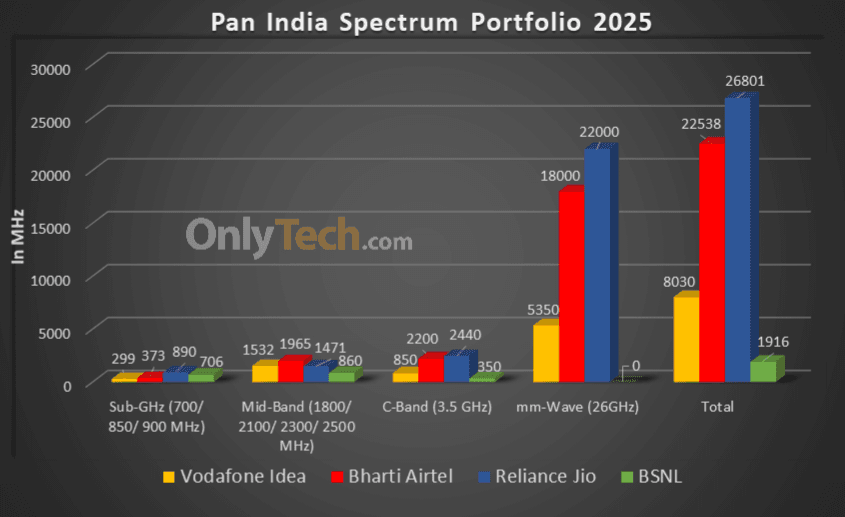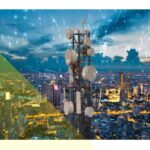Spectrum is for telecommunication what jet fuel is for aviation. Spectrum is a range of electromagnetic frequencies or airwaves that telecom companies use for establishing a connection between a cell tower and a mobile phone. The bandwidth of this spectrum is directly proportional to the speed of a wireless data network (since more data can be transmitted simultaneously through a broader data pipeline). In contrast, the frequency is inversely proportional to the coverage (since lower frequencies penetrate better through physical barriers and thus have wider coverage).
The spectrum holding data sheet embedded in this article represents the current spectrum holdings of all active telecom operators across all frequency bands across all 22 telecom circles along with their liberalisation status and expiry dates. All figures represented are in MHz. The value mentioned in the bracket beside the frequency at the base of each sheet is the band number where ‘B’ stands for 4G LTE band whereas ‘n’ stands for the corresponding 5G NR band.
The spectrum shown under BSNL and Aircel in white is reserved for the respective operators but has not yet been officially allotted to them.
Spectrum Liberalisation:
Spectrum was administratively allocated to operators in each of the 22 licensed service areas or circles prior to 2010, this spectrum is called non-liberalised and can only be used for 2G services whereas all airwaves allotted post-2010 have been through a Spectrum Auction where operators have paid the market discovered price and this spectrum is called liberalised and can be used for any technology platform 2G/3G/4G/5G. Alternatively, operators may choose to liberalise their administratively allotted spectrum by paying the market-discovered price to DoT on a pro-rata basis for the remaining validity of the spectrum.
Paired and Unpaired spectrum:
Spectrum may be paired or unpaired, bands 1/3/5/8/28 are all paired where one set of frequencies is used for uplink whereas another distinct set of frequencies is used for downlink known as Frequency-division duplexing (FDD), whereas bands 40/41/78/258 are unpaired where both uplink and downlink happens in the same set of frequencies separated by the time of uplink and downlink known as Time-division duplexing (TDD).
List of Indian FDD Bands:
| 4G LTE band | 5G NR band | Uplink frequency range (MHz) | Downlink frequency range (MHz) | Bandwidth for telecom (MHz) | Block size (MHz) |
|---|---|---|---|---|---|
| B1 | n1 | 1939-1979 | 2129-2169 | 40×2 | 5×2 |
| B3 | n3 | 1710-1780 | 1805-1875 | 70×2 | 0.2×2 |
| B5 | n5 | 824-844 | 869-889 | 20×2 | 1.25×2 |
| B8 | n8 | 890-915 | 935-960 | 25×2 | 0.2×2 |
| B28 | n28 | 723-733/ 738-748 | 778-788/ 793-803 | 20×2 | 5×2 |
List of Indian TDD Bands:
| 4G LTE band | 5G NR band | Frequency range (MHz) | Bandwidth for telecom (MHz) | Block size (MHz) |
|---|---|---|---|---|
| B40 | n40 | 2300-2380 | 80 | 10 |
| B41 | n41 | 2535-2555/ 2615-2655 | 60 | 10 |
| – | n78 | 3300-3670 | 370 | 10 |
| – | n258 | 24250-27500 | 3250 | 50 |
Spectrum caps:
A spectrum cap dictates how much spectrum a particular operator can hold in a circle for a specific band. There is a 40% cap for Sub-GHz spectrum in the 700/850/900 MHz bands combined, a 40% cap for Mid-Band spectrum in the 1800/2100/2300/2500 MHz bands combined, a 40% cap for the C-Band spectrum of 3300-3670 MHz and a 40% cap for the mm-Wave spectrum bands of 24.25-27.5 GHz. The current spectrum caps are denoted in the spectrum chart.
Overall spectrum holdings of operators (in MHz):
| Operator/Holding | Jio | Airtel | Vi | BSNL |
|---|---|---|---|---|
| Sub-GHz | 890 | 373.2 | 298.8 | 706 |
| Mid Band | 1470.8 | 1964.9 | 1531.6 | 860 |
| C-Band | 2440 | 2200 | 850 | 350 |
| mm-Wave Band | 22000 | 18000 | 5350 | 0 |
| Total | 26,800.8 | 22,538.1 | 8,030.4 | 1,916 |
Spectrum sharing/trading/leasing guidelines:
- Telecom operators holding CMTS/UASL/UL licenses can enter into a Spectrum-Sharing agreement with each other so long as both parties hold liberalised spectrum in the same band in the same circle. Spectrum sharing is possible only on a Pan LSA level in block sizes defined by DoT and only after one year of an operator acquiring the spectrum.
- Telecom operators holding CMTS/UASL/UL licenses can enter into a Spectrum-Trading agreement with each other so long as the spectrum being sold is liberalised. Trading of spectrum is possible only on a Pan LSA level in block sizes defined by DoT and only after two years of an operator acquiring the spectrum.
- Telecom operators may enter into a Spectrum-Leasing agreement only with Enterprises holding a Captive Non-Public Network (CNPN) license and not with each other. The lease may be limited to any geographic area within the LSA and for any duration mutually agreed upon by both parties. A CNPN licensee can lease spectrum from multiple operators within an LSA.
Note: We update this chart in real-time to ensure it is always up to date with the latest changes in spectrum holding. Certain human errors might have crept in during the manual compilation of the data, any mistakes/ rectification can be brought to the Team’s notice through the comments section below.








Chennai doesn’t have 900Mhz?
Vi?
Yes. Asking actually?
No
Chennai is a part of Tamilnadu circle, and both Airtel and Vi have 5 MHz in 900 MHz band there.
Vi finally started 2 sites with B8 in Chennai
Thank you for the update. I wish 1+3+8 CA goes live as well soon for Vi customers with speed cap removal and Vi buys band 41 in Tamil Nadu and Karnataka. And also, check in Kerala with 1+3+8+41 with snapdragon 8 Gen 1 phone or S21 FE. I wasn’t lying.
1+3+8+41 doesn’t work in Kerala already checked with Oppo Reno6 it supports the combo. Send +#0011# screenshot of that combo from samsung device
Reno 6 doesn’t support that combo. Only snapdragon 8 gen 1 powered devices.
Reno6 is Mediated powered device it supports the combo. Check cacombos.com
There is difference between 1-3-8-40 and 1-3-8-41. It doesn’t support 1-3-8-41. Only snapdragon 8 Gen 1 phones do support 1-3-8-41 and 1-40-41/40-41(South East Asian variant supports this combination, Vi has enabled this last year after refarming band 1 for 4G. Right now don’t know as I have not seen on my current device). I have never seen later though. I have never 1-3-8-40 in Maharashtra circle on my edge 30 pro/one Plus 10 Pro.
I know about Reno 6. Used it and thrown it. Speeds not crossing 150Mbps on 4*4MIMO as well. Also had to roll back software lot of times due to bugs in Color OS 12. Reno 7 got Color OS 12 Android 12 a week back. Complete trash to be honest. Malaysian Reno 7 with snapdragon 778G has stable 3CA with speeds above 150Mbps easily. Never going to purchase Dimensity powered device again. Realme 9 Pro Plus supports 2CA trash for 26K. Poco F4 3CA with speeds capped to 120Mbps. Mi11X gives better speeds on 1-3. Not acceptable. iQOO all devices 2CA trash. We need 3CA devices soon. Only Motorola providing them(I hope Moto Edge 40 or Moto G series bring snapdragon 7 Gen 1 with 4CA under 30K next year). I wish Airtel and Vi upgrades band 3 and band 1 to 4*4MIMO everywhere around the country(This is important to compete with Jio). We don’t need 5G yet. But Jio will launch it on 100Mhz of n78+10Mhz of n28 and boom, their revenues will be touching four times of current revenues.
Bro Reno6 supports the combo 1+3+8+41 and also about speeds Dimesnsity performs almost same as Snapdragon. It hit 350Mbps in Vi Kerala on 1+3+8+40 Combo already if ur there in TG I’ll send screenshot too.
3-5-40 is in testing in Maharashtra circle for Airtel. Its not stable, but it is in testing mode.
Yes 1+3+8 is enabled in that site with B8. I don’t think Vi will buy B41 in TN and KA.
What’s the reason behind this?
So according to ET, 27.5 to 28.5GHz will be shaved off the 5G auctions for the satcom business. That’s a huge 1GHz chunk! What a disappointment!
It’s not gonna matter much tbh. Even if the telcos get 800 MHz each (which is a lot), there will still be no requirement of the satellite communication spectrum.
24.25 ghz + 0.8×4 ghz = 27.45 GHz
Besides, our country is in dire need of good satcom infrastructure both from a general connectivity and strategic standpoints.
Yeah, even 100MHz gives a good gigabit without CA and 4×4 MIMO, so even 800MHz each would be sufficient for all 3 operators.
So here’s the thing: 4×4 MIMO is not technically feasible in existing mmWave antennas. What you’re referring to is C-band spectrum.
mmWave antennas have 2×2 MIMO at best.
But given the attitude of Indian telcos i seriously doubt they’ll buy 100 MHz each of n78.